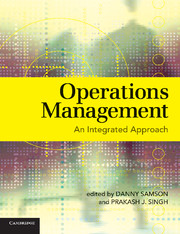Book contents
- Frontmatter
- Contents
- List of Contributors
- Preface
- Acknowledgements
- Part I Operations within Organisations – Building Blocks
- Part II Approaches to Understanding OM
- Part III Moving Forward with OM – Creating Competitive Advantage
- Part IV Challenges and Opportunities in Operations
- Part V Case Studies
- 1 Innovation in the Biotechnology Sector: The Case of IDT Australia
- 2 New Zealand King Salmon: Value-Chain Innovation
- 3 Pilila Clothing Company Goes Lean
- 4 From Singapore to the World: Port Management in Singapore
- 5 Striving for Operations Excellence within Queensland Rail Supply Division
- 6 Should I Stay or Should I Go? Shiraishi Garments Company
- 7 Towards a Green Supply Chain: Toyota Australia
- 8 Process Analyses and Improvement at Bartter Enterprises
- 9 Operations Challenges at Firth Industries Limited, Wellington Division
- 10 Ford Motor Company: Moving Forward in Australia
- 11 Technology Transfer at Hero Honda
- 12 Why Is the Patient Resident Time so Long?: The Case of St Martin's and Charity Private Hospital
- Index
11 - Technology Transfer at Hero Honda
Published online by Cambridge University Press: 05 June 2012
- Frontmatter
- Contents
- List of Contributors
- Preface
- Acknowledgements
- Part I Operations within Organisations – Building Blocks
- Part II Approaches to Understanding OM
- Part III Moving Forward with OM – Creating Competitive Advantage
- Part IV Challenges and Opportunities in Operations
- Part V Case Studies
- 1 Innovation in the Biotechnology Sector: The Case of IDT Australia
- 2 New Zealand King Salmon: Value-Chain Innovation
- 3 Pilila Clothing Company Goes Lean
- 4 From Singapore to the World: Port Management in Singapore
- 5 Striving for Operations Excellence within Queensland Rail Supply Division
- 6 Should I Stay or Should I Go? Shiraishi Garments Company
- 7 Towards a Green Supply Chain: Toyota Australia
- 8 Process Analyses and Improvement at Bartter Enterprises
- 9 Operations Challenges at Firth Industries Limited, Wellington Division
- 10 Ford Motor Company: Moving Forward in Australia
- 11 Technology Transfer at Hero Honda
- 12 Why Is the Patient Resident Time so Long?: The Case of St Martin's and Charity Private Hospital
- Index
Summary
This case is of the partnership and the technology transfer between a leading Japanese company (Honda) with leading edge automotive technology, and an Indian company (Hero Motors) with a sound domestic market share and solid local reputation. Each had the potential to add significant value to the other, conditional upon their core value systems being compatible. One company, Hero, had the local market presence and the other Honda, had the right technology, in other markets.
The key question is how to make optimal use, in terms of value creation, of technological leadership, in a foreign market that is relatively less sophisticated than that of the technology source. Such matters are strategic issues, not tactical for both the international source and the local host company. The degree to which the technology is appropriate is measured in both technical terms, and most importantly in business, market and financial terms. Strategic technology management for stakeholders engaged in a major international technology transfer refers to the decisions of resource-base, design, technical specifications, organisational arrangements and fees, incentives, financials and contracts, marketing, manufacturing, branding and supply chain, and finally, leadership and cultural and philosophical fit of those stakeholders.
In the early 1980s the Indian economy was opening up and foreign companies and technologies were allowed to come into the sectors of strategic importance. Many automobile manufacturing firms were finding their way to the Indian market.
- Type
- Chapter
- Information
- Operations ManagementAn Integrated Approach, pp. 527 - 535Publisher: Cambridge University PressPrint publication year: 2008



